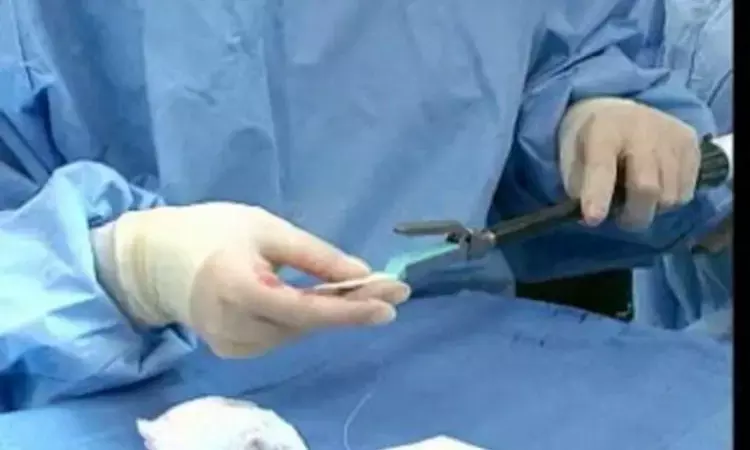- Home
- Medical news & Guidelines
- Anesthesiology
- Cardiology and CTVS
- Critical Care
- Dentistry
- Dermatology
- Diabetes and Endocrinology
- ENT
- Gastroenterology
- Medicine
- Nephrology
- Neurology
- Obstretics-Gynaecology
- Oncology
- Ophthalmology
- Orthopaedics
- Pediatrics-Neonatology
- Psychiatry
- Pulmonology
- Radiology
- Surgery
- Urology
- Laboratory Medicine
- Diet
- Nursing
- Paramedical
- Physiotherapy
- Health news
- Fact Check
- Bone Health Fact Check
- Brain Health Fact Check
- Cancer Related Fact Check
- Child Care Fact Check
- Dental and oral health fact check
- Diabetes and metabolic health fact check
- Diet and Nutrition Fact Check
- Eye and ENT Care Fact Check
- Fitness fact check
- Gut health fact check
- Heart health fact check
- Kidney health fact check
- Medical education fact check
- Men's health fact check
- Respiratory fact check
- Skin and hair care fact check
- Vaccine and Immunization fact check
- Women's health fact check
- AYUSH
- State News
- Andaman and Nicobar Islands
- Andhra Pradesh
- Arunachal Pradesh
- Assam
- Bihar
- Chandigarh
- Chattisgarh
- Dadra and Nagar Haveli
- Daman and Diu
- Delhi
- Goa
- Gujarat
- Haryana
- Himachal Pradesh
- Jammu & Kashmir
- Jharkhand
- Karnataka
- Kerala
- Ladakh
- Lakshadweep
- Madhya Pradesh
- Maharashtra
- Manipur
- Meghalaya
- Mizoram
- Nagaland
- Odisha
- Puducherry
- Punjab
- Rajasthan
- Sikkim
- Tamil Nadu
- Telangana
- Tripura
- Uttar Pradesh
- Uttrakhand
- West Bengal
- Medical Education
- Industry
Does reinforced stapler use reduce pancreatic fistula rates during distal pancreatectomy?

France: Findings from a randomized clinical trial suggest against the use of a reinforced stapler (RS) during distal pancreatectomy (DP) to reduce the rate of pancreatic fistula (PF). The findings from the REPLAY multicenter randomized clinical trial were published in the Annals of Surgery.
Distal pancreatectomy is generally performed for malignant pancreatic body and tail neoplasm. Despite improving operative techniques and perioperative management for pancreatic surgery, postoperative pancreatic fistula remains the major cause of mortality and morbidity following distal pancreatectomy, affecting about 5-32% of all cases.
Pancreatic fistula causes abdominal pain, fever, and abdominal abscess and sometimes can lead to pseudoaneurysm, causing lethal intraperitoneal hemorrhage. Additionally, it increases hospitalization costs and hospital stays. Also, it can delay adjuvant therapy for malignant pancreatic tumors, which may impact the patients' long-term outcomes. To date, there is no consensus on managing the pancreatic stump. Surgical staplers are commonly used for distal pancreatectomy and potentially represent a simple way to decrease pancreatic fistula rate.
Against the above background, Aude Merdrignac from Rennes University Hospital in France and colleagues conducted the REPLAY(Reinforcement of the pancreas in distal pancreatectomy) to evaluate the effect of using a reinforced stapler during distal pancreatectomy on postoperative outcomes. REPLAY is a prospective, multicenter, randomized study.
The study included 199 patients who underwent distal pancreatectomy. They were randomized in a ratio of 1:1 in two groups, 99 for using a standard stapler (SS) or a reinforced stapler (RS) to close remnant pancreatic parenchyma. The rate of the overall pancreatic fistula was determined (primary endpoint). Secondary endpoints were the length of hospital stay, the severity of pancreatic fistula, the rate of readmission for a PF within 90 days, and overall morbidity. Participants were blinded to the procedure carried out.
The study led to the following findings:
- In the study, one patient who did not undergo surgery was excluded. Baseline characteristics were comparable in both groups.
- The rate of the overall pancreatic fistula was higher in the RS group (SS: 67.7%, RS: 83%), but the rate of the clinically relevant pancreatic fistula was similar (SS: 11.1%, RS: 14%).
- The mean length of total hospital stay, postoperative morbidity, readmission for PF, and mortality at 90 days were comparable.
"Our findings do not favor using a reinforced stapler during distal pancreatectomy to reduce the rate of pancreatic fistula," the authors conclude.
Reference:
Merdrignac A, Garnier J, Dokmak S, Regenet N, Lesurtel M, Mabrut JY, Sa Cunha A, Fuks D, Bergeat D, Robin F, Le Pabic E, Boudjema K, Turrini O, Laviolle B, Sulpice L. Effect of the Use of Reinforced Stapling on the Occurrence of Pancreatic Fistula After Distal Pancreatectomy: Results of the REPLAY (REinforcement of the Pancreas in distaL pAncreatectomY) Multicenter Randomized Clinical Trial. Ann Surg. 2022 Nov 1;276(5):769-775. doi: 10.1097/SLA.0000000000005618. Epub 2022 Jul 25. PMID: 35876371.
Dr Kamal Kant Kohli-MBBS, DTCD- a chest specialist with more than 30 years of practice and a flair for writing clinical articles, Dr Kamal Kant Kohli joined Medical Dialogues as a Chief Editor of Medical News. Besides writing articles, as an editor, he proofreads and verifies all the medical content published on Medical Dialogues including those coming from journals, studies,medical conferences,guidelines etc. Email: drkohli@medicaldialogues.in. Contact no. 011-43720751


